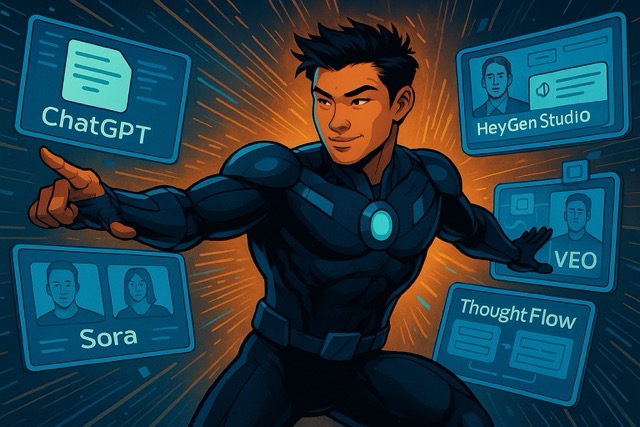Video 3.0: How AI Video is Revolutionizing Executive Communication Strategy
- David Hajdu

- Jun 14
- 4 min read
Updated: Aug 22
Last month, my buddy was telling me how he easily spends hours in a studio recording a quarterly update video. Between the teleprompter issues, lighting adjustments, and multiple takes to get the tone just right, it was, to put it gently, a magnificent waste of executive time. What if I told you this entire workflow is about to become as obsolete as fax machines? AI-powered video communication for executives is transforming how leaders share their vision and insights without the time-consuming traditional production methods.

For years, video has been "the next big thing." But let's be honest, most executives still treat video like a one-off production. A quarterly update. A keynote clip. A talking head interview. Useful? Sure. Strategic? Not even close.
Welcome to Video 3.0.
The Evolution of AI Video From Hero Clips to AI Integration
Video 1.0 was the era of the hero clip. A big production, once or twice a year, to impress clients or investors. Think: sizzle reels, company overviews, product launches. These productions required professional crews, substantial budgets, and days of planning. Valuable? Sure. Repeatable? Not really.
Video 2.0 was the democratization of production. Tools like CapCut, Canva, and smartphones put editing in everyone's pocket. This was the age of the B-roll. Quick cuts. Talking heads. Repurposed webinars. Everyone became a content creator, but the strategic impact remained limited by human bandwidth.
I once attempted to maintain a weekly video series alongside running Edge8.ai. By week three, I was spending more time on lighting than on actual business strategy. Something had to give.
But now, we're entering Video 3.0. And this changes everything.
What Is Video 3.0?
Video 3.0 is the integration of AI into every step of the video content lifecycle: from strategy to scripting, avatar-based delivery, multi-language voiceovers, and fully automated repackaging for every channel.
It's about using AI to:
Generate scripts based on your LinkedIn posts, meeting notes, or internal memos
Record those scripts using an avatar that looks and sounds like you (with tools like HeyGen or Synthesia)
Translate and localize for different markets automatically
Repurpose long-form content into clips, reels, blog posts, and even sales scripts
Suddenly, your weekly insight becomes a month's worth of strategic content without you ever stepping into a studio.
This is how modern executives scale thought leadership. Without burnout. Without bottlenecks.
The Real-World Impact on Leadership Communication
Most executives already know that video performs better than text. LinkedIn posts with video get 5x more engagement. Email open rates increase by 19% when "video" appears in the subject line. What leaders haven't solved is the execution problem. They want to show up consistently, but they can't spend 5 hours every week rehearsing and recording.
Video 3.0 fixes this fundamental constraint. It lets your ideas scale without requiring your time.
In the same way ChatGPT made writing accessible to non-writers, AI-powered video communication for executives makes video accessible to leaders who don't have time for cameras, teleprompters, or retakes.
And here's the kicker: done right, this isn't just a time-saver. It's a revenue generator.
Because when your voice is showing up consistently, clearly, and authentically, your audience listens. Whether they're customers, investors, employees, or partners.
Addressing the Authenticity Question
"But won't it feel fake?"
That's the most common concern I hear. And honestly? If you do it wrong, yes. It will feel fake.
But done right, AI-powered video isn't about replacing you. It's about scaling you. Your voice. Your tone. Your expertise. We're not creating deepfakes, we're capturing the real insights that live in your head and turning them into powerful, platform-ready assets.
It's the same reason Elon Musk turned Twitter into X. He understood that whoever controls the content stream controls the AI future. Your content is your data advantage. And video is the highest-leverage format.
How Leaders Should Adapt Today
If you're a business leader wondering how to implement Video 3.0 in your organization, start here:
Audit your current content. Where are you already creating value through writing, speaking, or internal communication?
Identify your "thinking leverage points." Are your best insights coming from customer calls? Team meetings? Your morning journaling routine?
Start simple. You don't need to build a full AI studio overnight. Begin with converting one existing content stream (like your company-wide emails) into video format using basic AI tools.
Focus on systems, not viral moments. The power of Video 3.0 isn't in creating one breakout hit. It's in maintaining a consistent presence that compounds over time.
The executive who embraces this approach isn't just saving time. They're fundamentally changing how ideas flow through their organization and out into the market.
The Road Ahead
The future of business communication is visual, AI-enhanced, and always-on. The leaders who adapt first will have a distinct advantage in market presence, team alignment, and customer connection.
At Edge8.ai, we've been building these systems not just for ourselves, but for forward-thinking executives across industries. The results have been transformative, not just in content output, but in how these leaders think about their own ideas and their capacity to influence at scale.
The question isn't whether video will become central to your leadership communication strategy. The question is: will you lead this transformation, or fall behind?
If you're interested in learning more about how to implement Video 3.0 in your organization, should me an email at dave@edge8.ai


Comments